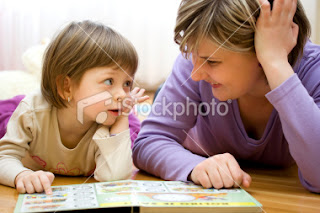Blevins (1997) describes the earlier work of theorist Marilyn Jager Adams in designing five types of phoneme awareness tasks that can be used
in the classroom. These align well with the International Reading Associations’ Reading Panel Report,
Teaching Children to Read (2002) and its analysis of phoneme awareness skills.
- Task 1—the ability to hear rhymes and alliteration—for example, the children listen to a poem, rhyming picture book or song and identify the rhyming words heard.
- Task 2—the ability to do oddity tasks (recognize the member of a set that is different [odd] among the group)—for example, the children look at the pictures of a door, a dog, and a cat, and say each word. The teacher asks which starts with a different sound.
- Task 3—the ability to orally blend words and split syllables—for example, the children can say the first sound of a word (e.g., /b/) and then the rest of the word (/at/) and then put it together as a single word (bat), as in onsets and rimes.
- Task 4—the ability to orally segment words—for example, the ability to count sounds. The children would be asked as a group to count the sounds in “sat” (/s/, /a/, /t/--3 sounds).
- Task 5—the ability to do phoneme manipulation tasks—for example, replace the “r” sound in rose with a “n” sound and say “nose.”
Other instructional methods that may be effective for teaching phonemic awareness include:
- Clapping the SOUNDS (not syllables) in words. (e.g., “bat” has three sounds, /b/, /a/, /t/)
- Games where students must identify the beginning, middle, or end sound (not letter) of a word (e.g., “Find something that begins with the /t/ sound”).
- Games with common nursery rhymes where the students change one sound in several words (e.g., “Jack and Jill went up the hill…” Now change Jack and Jill to begin like ‘Mary”)
- Using visual cues and movements to help children understand when the speaker goes from one sound to another. This can also be done with colored blocks, a different color for each sound, and children can move their blocks around as the teacher moves the sound around (e.g. starting with three different colored blocks for “cat” and changing the “word” to “tac.”)
- Singing familiar songs (e.g., Happy Birthday, Knick Knack Paddy Wack) and replacing key words with words with a different ending or middle sound (oral segmentation).
- Dealing children a deck of picture cards and having them sound out the words for the pictures on their cards or calling for a picture by asking for its first and second sound.
- Onset and rhyme games where children are given a beginning sound and told to blend it with a specific series of endings (e.g., “OK, start with /ch/ and add “eep’ then “eet” etc.)
- Games like “I’m going on vacation and I’m taking a (something that begins or ends with a particular phoneme)
- Auditory games and drills during which students recognize and manipulate the sounds of words, separate or segment the sounds of words, take out sounds, blend sounds, add in new sounds, or take apart sound to recombine them in new formations are good ways to foster phonological awareness
- Using kinesthetic feedback, particularly the position of the lips, teeth and tongue, as well as the vibration of the voice box, to identify various phonemes.
Read More :
Phoneme Awareness Activities
